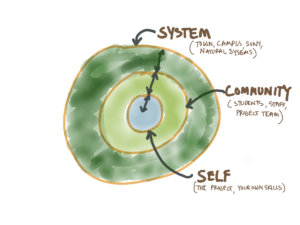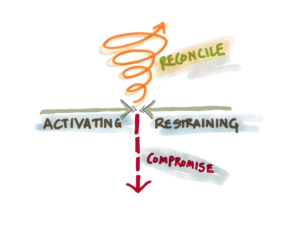
Backward and Incomplete
I say we often do things in a way that is backward and incomplete.
What I mean is that we don’t slow down enough to understand, as a group, why we are working on a project, or what is important about the work. We don’t even slow down enough to make sure we are including the needed people, perspectives, and knowledge. It may be fairly easy to point to the value in a completed project, but I can tell you the value will be amplified if the goal-set defines the values you seek from the start.
It’s like magic – intentional crafting of knowledge access beyond the normal.
Recently this has come to the foreground in everything including my day job, work at the state level, and work in a couple of volunteer groups I’m engaged in. All of a sudden, the need to define Core Principles has become clear. I was recently asked if I had a template or any guidance on how to define core principles. So I did a quick google search, which I often do, and I did not find anything that was simple or complete. I found some examples that touted a list of qualities the companies called core principles, but these were statements such as “integrity” and “innovation”, written bold and in pretty fonts; These are more personality traits than anything else, and certainly not defining the kernel of truth for the specific work at hand.
I am now called to put pen to paper (or fingers to keys, rather) and define Core Principles, and provide some useful guidance as to how to develop them.
First, we can make our current processes a bit more accepting of the idea of Core Principles by the small tweak of making introductions useful. Begin a meeting to highlight the skills that can and should inform the work. “HI, My name is Jodi, and I am passionate about Nature in the space and about embodied carbon and how to reduce it.” This is very different than “Hi, I’m Jodi, Director of Sustainability Programs for a NY state authority, and an architect.”
Or try introductions that call for each person to state the ONE THING they hope this project accomplishes – “Hi, I’m Jodi, and I really want this project to be an example of carbon reductions that we can share with all state entities to inspire their work.” Or even more simple, such as ”Tell us your name, and why you are here,” or “Tell us why you think we need to do this thing we are going to do? Why do you think this project is valuable?”
When have you ever started a project with this level of clarity? Even this small change to your meetings will start to activate an awareness of the project’s place in the world, and the impact the individuals can have on the work.
Next comes the real change. The work to discover the foundational project truths that should inform all of the ensuing work of the team, the Core Principles. This is a list of simple ideas that each rendition of the progress can be reviewed against to make sure you’re on track to achieve what you need to achieve. In most cases, these principles will do two seemingly contradictory things 1) keep the focus tight and right and 2) keep the awareness of co-benefits and co-burdens active. It’s like magic – intentional crafting of knowledge access beyond the normal.
How do we do this?
Reality #1 – The first step is to recognize that this will take some time.
Go slow. Learn from Nature and recognize that the nutrients (greater knowledge) will only penetrate the soils (project) if the river (the process) is burbling over rocks, meandering slowly, and taking curves to help nutrient flow into the soil. So the first meeting, depending on number of people in the room, should be fully spent on the informative introductions, as in the examples above, and then on understanding the potential for the project.
- Start big – Spend some time defining the context of the work. What is the project? (Simple description of the known programmatic goals) What systems interact directly with the project? (Think about the power systems, transit systems, local workforce, and the occupants) What aspects of Nature inform or should be informed by the project? (Are you affecting the local aquifer, is this project going to change the dynamic in the local community, are the wind patterns useful) Capture the full array of answers and then discuss how they inform who should be considered a stakeholder for the work.
- (or) Start small – Pose direct questions to the team such as “What could this project accomplish for the community?” “How do you see this new building functioning perfectly?” “Who should benefit from this project that we haven’t yet considered?” “Are there health goals for the new space?” These questions can start to define the stakeholders, the nested systems, and the support of equity. They can back you into a decent understanding of context.
 Reality #2 – Embrace the contradictory principles as information that will benefit the work.
Reality #2 – Embrace the contradictory principles as information that will benefit the work.
In a recent set of meetings discussing what students will need for their residence halls in the future, we discovered that we need to protect health, AND support the human need to congregate. These two ideas seem at complete odds in the time of COVID, don’t they? Yet we need to work together to understand how these can inform each other. And we’re not talking about compromise, where each goal is subjugated to the other, but about a regenerative approach where we reach for exceptional solutions beyond what would be revealed by exploring one core concept, and then, linearly, the other. In this case we are still working on the problem, but these two core principles, kept in flux together, help us to see possibilities we may not have even considered before. We can create gathering spaces of ample size with specific ventilation and filtration to support some gatherings. We could introduce a cleaning protocol particularly after these gatherings. Maybe we can protect students by providing single occupancy mini-rooms with personal bathrooms and then provide ample outdoor gathering spaces with protections from wind, and sensible radiant heating for classroom and event gatherings later into the fall (in the upper NE).
 If we looked at one OR the other, we would degenerate into a focus on risky, uninformed, solutions. Looking only at health, we might create only solo bedrooms and private baths with very little interaction. Would we increase depression? Would we create restrictions that would be dangerously undermined by students? Would we restrict the development of emotional or social IQ? If we focus solely on the need to engage and interact, we will not doubt increase health risks.
If we looked at one OR the other, we would degenerate into a focus on risky, uninformed, solutions. Looking only at health, we might create only solo bedrooms and private baths with very little interaction. Would we increase depression? Would we create restrictions that would be dangerously undermined by students? Would we restrict the development of emotional or social IQ? If we focus solely on the need to engage and interact, we will not doubt increase health risks.
Reality #3 – This is a fleshing out of ideas that will take a few cycles of refinement.
Sort of like sketching to frame up the drawing on the sheet, then solidifying the main subject, then layering in the paints, beginning to refine the highlights and detail, finally, adding a finish gloss and your signature. Once a series of statements is defined, it is a worthy effort to discuss them in a second meeting, and identify the top 3-5 most compelling ones. Then see if the other principles can be realized within clearer statements of those top few principles. In this way, the team can reduce any feeling of being overwhelmed, while the principles are crafted to be essential and succinct (and, perhaps, memorable).
Reality #4 – Usually all Core Principles must be considered together.
And in some cases there may be an ability to define some as “Non-negotiable” and some as “ideal if possible”. In the time of COVID-19, I suggest the ideas about student health and the human need to congregate are non-negotiable. Say there was also a stated principle about this project reducing the cost of higher education for the average student. This may be a non-negotiable for some campuses, but may not be for others. Regardless, keeping this as a core principle, to inform the work as it progresses, will help the team to pay attention to innovating ways to reduce costs.
Reality #5 – Never forget these Core Principles are living, growing, changing ideas that are here to support the work.
They need to be used. Review them at each phase of the work or when a big design or approach decision is made. If they become punitive or restrictive, you must also take the time to discuss them with the team, and make the changes that are needed either to the principles or to the process or to the design.
In summary, Core Principles are intended to do a few, very important, things.
- Reveal the preconceptions of the participants in the work as sort of a cautionary reminder list – don’t forget this, that, and the other.
- Identify the needed expertise to create more complete discovery. If there is a statement about maintaining health, then perhaps a health expert should be included in the work.
- Push the thinking to identify interdependence (co-benefits and co-burdens). There is no action that does not have “unintended consequences”, so let’s work to identify those and strengthen our deliberate affects.
- Broaden the time-parameters acknowledged in the work. Awareness of how this effort fits the historic context and the potential future needs is powerful in the extreme.
- Ensure other contextual issues are identified and those goals are supported. If a municipality has a carbon plan, shouldn’t THIS project support that goal?
Wouldn’t it be powerful if your whole team understood and could immediately share the essential focus of your work? And from this point on, after the Core Principles are defined and agreed to (oh, everyone must agree to them, BTW) the work can be fast.
If the team knows the goals, can cite the essential focus, and understands the skills at the table, then actual communication and planning can occur. Instead of backward and incomplete, you will be able to move forward at speed with a shared, clear, and deeply consistent understanding of the work at hand.
Define the Core Principles, and be greener,
Jodi
3 Others like this post, how about you? (no login required)
